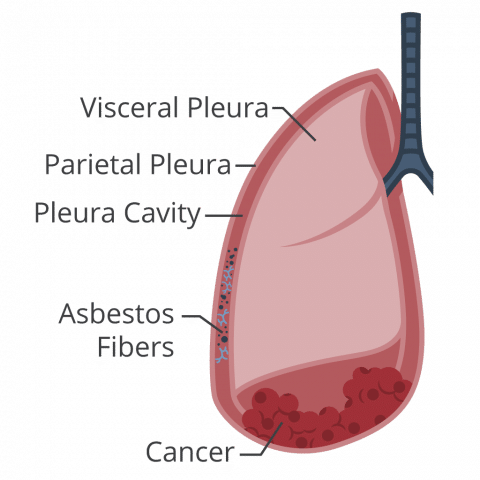What Is Pleural Mesothelioma?
Pleural mesothelioma is a rare cancer caused by breathing in microscopic asbestos fibers, usually in the workplace. Doctors diagnose about 3,000 new cases of pleural mesothelioma each year in the U.S.(1) Few cases of mesothelioma were diagnosed prior to the start of widespread asbestos use more than a century ago.
Asbestos was widely used in thousands of commercial products and became a staple of construction and general industries in the U.S. beginning in the late 1800s. Many people who are being diagnosed with pleural mesothelioma today were exposed to asbestos while serving in the military or in their jobs prior to the 1970s, when the health consequences of asbestos exposure led the U.S. Occupational Safety and Health Administration (OSHA) to impose severe restrictions on exposures.

People continue to be at risk of developing the disease because activities such as brake relining and renovations of old buildings can disturb asbestos-containing materials and release toxic fibers into the air, endangering anyone who inhales them. People who haven’t worked directly with asbestos but have been exposed to its toxic fibers through washing, cleaning, or touching asbestos-contaminated work clothes can also develop mesothelioma.
Diagnosed with mesothelioma after being exposed to asbestos? Explore your legal options with a free consultation.
Get a Free Case ReviewSadly, there is no cure for pleural mesothelioma, and the risk of developing the disease does not go away over time after a person is no longer exposed to asbestos.(2) The disease has a lengthy latency period, meaning decades may pass between being exposed to asbestos and the onset of symptoms.(3) The average age at the time of diagnosis for pleural mesothelioma is 72.(4)
How Asbestos Causes Pleural Mesothelioma
Pleural mesothelioma develops in the pleura, which are thin sheets of tissue that help protect the lungs. An inner layer of tissue called the visceral pleura lines the lungs; an outer layer called the parietal pleura lines the chest wall and the diaphragm.
Between the two layers is the pleural cavity, or the pleural space. A small amount of lubricating fluid within the pleural space allows the two layers of pleura to slide over each other easily and move smoothly against the chest wall when the lungs expand and contract as a person breathes.(5)

However, when a person inhales asbestos fibers, the fibers can become stuck in both the inner and outer pleura and can trigger a toxic process that takes 10 to 50 or more years to cause cancer.
The body cannot rid the pleura of all the asbestos fibers and, over time, these fibers can cause irritation, inflammation, and scarring.(6) The fibers can also cause cells to mutate and multiply uncontrollably, creating tumors. The cancer that can form as a result is known as pleural mesothelioma.
The deadly disease causes fluid to accumulate between the layers of the pleura which presses on the lungs, preventing them from expanding and contracting normally. This makes it hard to breathe — one of the many symptoms of the disease.(6)
Symptoms of Pleural Mesothelioma
Symptoms of mesothelioma often do not appear right away. When people with mesothelioma finally do experience symptoms, the disease usually is in later stages.(7)
Symptoms of pleural mesothelioma include:
- Chest or lower back pain
- Shortness of breath
- Cough
- Fever
- Excessive sweating
- Fatigue
- Unexplained weight loss
- Trouble swallowing
- Hoarseness
- Swelling of the face and arms(8) (9)
Many diseases of the lungs and respiratory system have similar symptoms. This makes diagnosing pleural mesothelioma critically important.
Diagnosing Pleural Mesothelioma
While there is no one single test to specifically diagnose the disease, doctors rely on a number of ways to determine if someone has pleural mesothelioma.
To start, a doctor may perform a physical exam, checking a patient’s general health and looking for signs of disease. The doctor may also ask questions about exposure to asbestos.
In addition to a physical exam, a doctor may use other tests to assist in the diagnosis of mesothelioma, including:
If a doctor reaches a pleural mesothelioma diagnosis, the next step is to determine the stage (or extent) of the cancer.
Were you or a loved one diagnosed with mesothelioma? Call for a free legal consultation.
(917) LAWYERSPleural Mesothelioma Stages
Doctors determine the stage of pleural mesothelioma based on the results of physical exams, biopsies, and imaging tests, including CT scans and Positron Emission Tomography (PET) scans.
Sadly, by the time doctors diagnose pleural mesothelioma, the cancer is usually in an advanced stage. The stages are numbered I through IV, with IV being the most advanced.
Stage I
If a mesothelioma case is classified Stage I, it means the cancer has grown into the pleura lining the chest wall on one side of the chest. The cancer in this stage has not spread to the lymph nodes or other organs.
Stage II
Stage II means the cancer has spread into the diaphragm or the lung itself, but it has not spread to the lymph nodes or other organs.
Stage III
If pleural mesothelioma is classified Stage III, it may have spread to lymph nodes on the same side of the tumor, but it has not spread to other organs.
Stage IV
Stage IV is the most advanced stage of pleural mesothelioma. If pleural mesothelioma is classified Stage IV, it may have spread to lymph nodes and other organs.(10)
The stages of people’s cancers affect the treatment options available to them. To date, pleural mesothelioma treatments have not led to a cure. Treatments currently are done to reduce symptoms and help extend life.
Treating Symptoms of Pleural Mesothelioma
Many doctors lack extensive experience in treating pleural mesothelioma because it is so rare. Doctors may instead refer you to specialists who are more accustomed to treating symptoms of the disease.
Weitz & Luxenberg does not provide medical advice, and the decision of which treatment options are best in any given situation is a matter between a patient and his or her doctors.
Standard treatment options for pleural mesothelioma patients include surgery, radiation therapy, chemotherapy, and targeted therapy. Clinical trials are also testing new types of treatment.(11)
Pleural mesothelioma treatment can be very costly. Mesothelioma may also cause immense pain and suffering, only to end in death. With the help of a skilled mesothelioma lawyer, victims of pleural mesothelioma and their surviving loved ones may be able to receive compensation from the companies responsible for the asbestos exposure.
Compensation for Pleural Mesothelioma Victims
Several avenues exist for seeking compensation for injuries caused by asbestos exposure. Victims may choose to file a personal injury or wrongful death lawsuit and/or file a claim against a bankruptcy trust. An experienced mesothelioma lawyer will be able to explain your legal options and help determine your best course of action for achieving justice.
A nationally recognized leader in asbestos litigation, Weitz & Luxenberg has secured more than $8.5 billion on behalf of asbestos clients, some of whom tragically suffered from pleural mesothelioma.* Members of our compassionate team of more than 500 lawyers, paralegals, and support staff are available 24/7 to help victims navigate this incredibly challenging time in their lives.
Our attorneys work tirelessly to ensure our clients receive fair compensation for the injuries caused by negligent companies, so that pleural mesothelioma victims and their families may have financial security and achieve some closure.
To request legal help today, call (917) LAWYERS or fill out a form to speak with one of our team members at no charge.
